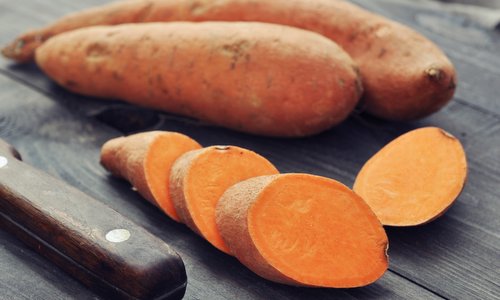Moroccan chicken and sweet potato tagine
- Overview
Ingredients
- 4 chicken breasts or 8 thighs, skin removed
- 3 tablespoons olive oil
- 2 red onions, chopped
- 2 sweet potatoes, washed and cut into chunks
- 1 butternut squash; peeled, deseeded and cut into chunks
- 650ml chicken stock
- 100g peeled root ginger, roughly chopped
- 100g tomatoes, roughly chopped
- 4 garlic cloves, peeled
- 1 teaspoon turmeric
- 1 tablespoon each of cumin, coriander and cinnamon
- 2 tablespoons red wine vinegar
- 150g dried apricots, halved
To serve
- Handful of chopped mint leaves
- Zest of 1 lemon
- 4 handfuls of spinach leaves, washed
- 150g quinoa, rinse well and cook like rice
Tzatziki
- 1 cucumber, grated and drained
- 400g bio-live/Greek yoghurt
- 2 cloves garlic, grated
- 4 leaves of mint, chopped and sprinkledover the top just before serving
Preparation Method

- Place the tomatoes, 1/2 of the chopped onions, garlic and ginger in a food processor to form a paste.
- Season the chicken, heat 2 tablespoons of oil in a flameproof dish and brown the chicken. Remove from pan.
- Heat remaining oil, fry onion until soft. Add spices and fry for 1 minute. Add the paste and fry for 3 minutes.
- Return the chicken with the squash, sweet potato, apricots, stock and vinegar.
- Allow to simmer for 25 minutes until the chicken is cooked through.
- Scatter with the lemon zest and mint leaves and serve with the cooked quinoa.
- Place a handful of uncooked spinach leaves on each plate and ladle the tagine on top. Serve with Tzatziki.
Nutritional information
Our backs are made up of bone, cartilage, tendons, ligaments and muscle and are formed from the protein we eat. To ensure a strong structure, our body requires a basic amount of protein in our diets. Chicken provides all 8 essential amino acids ensuring the body’s ability to repair during illness in order to keep this structure strong.
Quinoa is called the “mother grain” because of its remarkable properties. Not only is it a valuable protein, it is actually a seed which is rich in essential fats and therefore highly anti-inflammatory. It contains almost four times as much calcium as wheat, plus extra iron, B vitamins and vitamin E.
Vitamins B, A, C, and K are critical for back care. Calcium and magnesium are also essential for bone health and help to reduce muscle spasm. Squash, sweet potato and apricots, high in red and orange colours, contain carotenoids. They contain vitamins A, B and C along with calcium, magnesium and manganese. Working in concert these nutrients are powerful anti-oxidants that heal inflammation in the body.
Turmeric and ginger are renowned for their anti-inflammatory value. Studies have shown that turmeric’s anti-inflammatory effects are on a par with hydrocortisone but with none of the side effects. Even garlic acts as a reasonably effective anti-inflammatory due to a compound called diallyl disulphide.
Last updated Tuesday 7 June 2022
First published on Wednesday 2 September 2015
